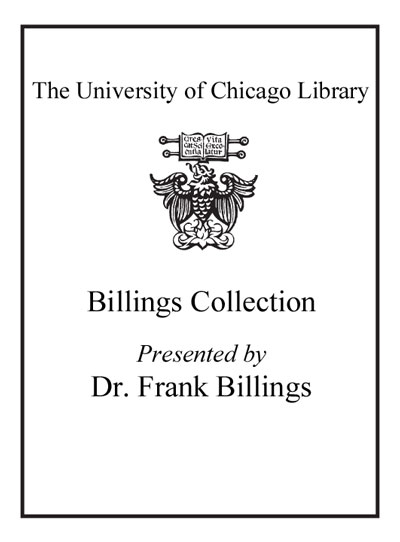Basic histology : text & atlas /
Saved in:
| Author / Creator: | Junqueira, Luiz Carlos Uchôa, 1920- |
|---|---|
| Edition: | 11th ed. |
| Imprint: | New York, N.Y. : McGraw-Hill, c2005. |
| Description: | viii, 502 p. : ill. ; 28 cm. + 1 CD-ROM (4 3/4 in.) |
| Language: | English |
| Subject: | |
| Format: | Print Book |
| URL for this record: | http://pi.lib.uchicago.edu/1001/cat/bib/5612743 |
Table of Contents:
- Contributors
- Preface
- 1. Histology & its Methods of Study
- Preparation of Tissues for Microscopic Examination
- Light Microscopy
- Phase-Contrast Microscopy & Differential Interference Microscopy
- Polarizing Microscopy
- Confocal Microscopy
- Fluorescence Microscopy
- Electron Microscopy
- Autoradiography of Tissue Sections
- Cell & Tissue Culture
- Cell Fractionation
- Histochemistry & Cytochemistry
- Detection Methods Using High-Affinity Interactions between Molecules
- Problems in the Interpretation of Tissue Sections
- 2. The Cytoplasm
- Cellular Differentiation
- Cell Ecology
- Cell Components
- The Cytoskeleton
- 3. The Cell Nucleus
- Cell Division
- The Cell Cycle
- Apoptosis
- 4. Epithelial Tissue
- The Forms & Characteristics of Epithelial Cells
- Specializations of the Cell Surface
- Types of Epithelia
- General Biology of Epithelial Tissues
- 5. Connective Tissue
- Cells of the Connective Tissue
- Fibers
- Ground Substance
- Types of Connective Tissue
- 6. Adipose Tissue
- Unilocular Adipose Tissue
- Multilocular Adipose Tissue
- 7. Cartilage
- Hyaline Cartilage
- Elastic Cartilage
- Fibrocartilage
- Intervertebral Disks
- 8. Bone
- Bone Cells
- Bone Matrix
- Periosteum & Endosteum
- Types of Bone
- Histogenesis
- Bone Growth & Remodeling
- Internal Structure of Bones
- Metabolic Role of Bone Tissue
- Joints
- 9. Nerve Tissue & the Nervous System
- Development of Nerve Tissue
- Neurons
- Cell Body
- Dendrites
- Axons
- Membrane Potentials
- Synaptic Communication
- Glial Cells & Neuronal Activity
- The Central Nervous System
- Meninges
- Choroid Plexus & Cerebrospinal Fluid
- Peripheral Nervous System
- Nerve Fibers
- Nerves
- Ganglia
- Autonomic Nervous System
- Degeneration & Regeneration of Nerve Tissue
- Neuronal Plasticity
- 10. Muscle Tissue
- Skeletal Muscle
- Cardiac Muscle
- Smooth Muscle
- Regeneration of Muscle Tissue
- 11. The Circulatory System
- Tissue Components of the Vascular Wall
- Structural Plan of Blood Vessels
- Vasa Vasorum
- Innervation
- Large Elastic Arteries
- Arterial Degenerative Alterations
- Carotid Bodies
- Carotid Sinuses
- Arteriovenous Anastomoses
- Medium (Muscular) Arteries
- Arterioles
- Capillaries
- Postcapillary Venules
- Muscular Veins
- Heart
- Lymphatic Vascular System
- 12. Blood Cells
- Composition of Plasma
- Staining of Blood Cells
- Erythrocytes
- Leukocytes
- Neutrophils (Polymorphonuclear Leukocytes)
- Eosinophils
- Basophils
- Lymphocytes
- Monocytes
- Platelets
- 13. Hematopoiesis
- Stem Cells, Growth Factors, & Differentiation
- Bone Marrow
- Bone Marrow As a Source of Stem Cells for Other Tissues
- Maturation of Erythrocytes
- Granulopoiesis
- Maturation of Granulocytes
- Kinetics of Neutrophil Production
- Maturation of Lymphocytes & Monocytes
- Origin of Platelets
- 14. Lymphoid Organs
- Antigens
- Antibodies
- Cytokines
- Cells of the Immune System
- Types of Immune Responses
- Lymphoid Tissue
- Mucosa-Associated Lymphoid Tissue & Tonsils
- Thymus
- Lymph Nodes
- Spleen
- 15. Digestive Tract
- General Structure of the Digestive Tract
- The Oral Cavity
- Tongue
- Pharynx
- Teeth & Associated Structures
- Esophagus
- Stomach
- Small Intestine
- Large Intestine
- Appendix
- 16. Organs Associated with the Digestive Tract
- Salivary Glands
- Pancreas
- Liver
- Biliary Tract
- Gallbladder
- 17. The Respiratory System
- Nasal Cavity
- Paranasal Sinuses
- Nasopharynx
- Larynx
- Trachea
- Bronchial Tree
- Pulmonary Blood Vessels
- Pulmonary Lymphatic Vessels
- Nerves
- Pleura
- Respiratory Movements
- Defense Mechanisms
- 18. Skin
- Epidermis
- Immunological Activity in the Skin
- Dermis
- Subcutaneous Tissue
- Vessels & Skin Sensorial Receptors
- Hairs
- Nails
- Glands of the Skin
- 19. The Urinary System
- Kidneys
- Bladder & Urinary Passages
- 20. Endocrine Glands
- Hormones
- Hypophysis
- Adenohypophysis
- Neurohypophysis
- Adrenal (Suprarenal) Glands
- Islets of Langerhans
- Thyroid
- Parathyroid Glands
- Pineal Gland
- 21. The Male Reproductive System
- Testes
- Intratesticular Genital Ducts
- Excretory Genital Ducts
- Accessory Genital Glands
- Penis
- 22. The Female Reproductive System
- Ovaries
- Oviducts
- Uterus
- Vagina
- Exfoliative Cytology
- External Genitalia
- Mammary Glands
- 23. Photoreceptor & Audioreceptor Systems
- Vision: The Photoreceptor System
- Hearing: The Audioreceptor System
- Index



